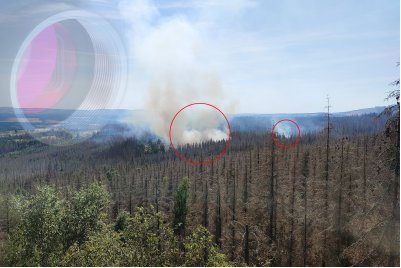Since 2009, the International Day for Disaster Reduction has been celebrated on 13 October. Proclaimed by the United Nations, it reminds us of the urgency of reducing disaster risks. The number of recorded natural disasters has risen steadily in recent decades. These include not only earthquakes, droughts and volcanic eruptions, but in our latitudes above all floods, storms, landslides and wildfires. The frequency and severity of climate- and weather-related disasters, as well as their destructive effects, are clearly increasing. Prevention of such events includes both measures to reduce risks in a targeted manner and the expansion of disaster management mechanisms to mitigate the consequences.
 Automatic forest fire detection system with intelligent image processing enables efficient fire fighting. Image Credit: IDS Imaging Development Systems GmbH
Automatic forest fire detection system with intelligent image processing enables efficient fire fighting. Image Credit: IDS Imaging Development Systems GmbH
"Disasters are increasingly influencing our everyday lives," explains Jan Hartmann, Managing Partner of the industrial camera manufacturer IDS Imaging Development Systems GmbH. It is important, he says, to use current and future technological possibilities to prevent accordingly. "Quite a few disasters are man-made due to massive interventions in the environment - such as deforestation, land sealing or pollution of the oceans.
This makes it all the more important that companies also increasingly act sustainably and do their bit." IDS recognizes the importance of preserving the natural foundations of life and strives to harmonies ecological, social and economic goals. The South German image processing company therefore not only acts prudently in its own business operations. With a view to global challenges such as climate change and the loss of biodiversity, the company relies on an approach that focuses equally on ecological responsibility and innovation. "In many areas, not only can processes be optimized and made significantly more sustainable with the help of our industrial cameras, for example by identifying and improving bottlenecks or inefficient processes. Innovative prevention potential also arises when our cameras are used in research, for example to investigate the effects of climate change," says Jan Hartmann.
Industrial cameras are increasingly used for research and prevention of environmental damage. Scientists use IDS cameras to investigate, for example, the development of a specific wave meteorology and its interaction with structures such as port infrastructures or wind farms. In this way, the effects of climate change on coastal morphology are researched and recommendations for action to protect them derived. In addition to prevention, industrial cameras are also proving their worth in damage limitation: heat waves caused by climate change are increasing sharply, and the associated risk of forest fires is rising. Fires in natural areas are increasingly getting out of control due to drought and wind. An integrated forest fire monitoring and information management system with intelligent image processing can help protect habitats and infrastructure. Through early fire detection and precise localization of fire outbreaks, it reduces the risk of spread and minimizes the associated damage to humans, animals, the environment and the national economy. For example, the automatic forest fire detection system ADELIE (Alert Detection Localization of Forest Fire), whose key components are industrial image processing and artificial intelligence, has proven itself. The system is successfully used in the Sarthe department, the most densely forested department in the north-western quarter of France.
The system is extremely powerful: it enables continuous monitoring of forests or forest fires, real-time visualization of the disaster, precise localization of the source of the fire and immediate alarm transmission. It also mitigates human risks and ensures continuous optimization of the system through analysis of stored data. "The ADELIE system has enabled us to improve the detection time and the accuracy of fire location," confirms Christophe Burbaud, chief commissioner of the Sarthe fire brigade.
With the help of drones, so-called Micro Air Vehicles (MAV), IDS cameras are also used for real-time mapping of disaster areas. As a flying eye, they capture, for example, earthquake zones or flooded cities, but also burning factories - and provide maps in real time that rescue forces can use immediately to assist in mission planning. "The spectrum of possible applications illustrates the great potential of visual and intelligent sensor technology as an enabler for sustainable solutions," adds Jan Hartmann. Development is also progressing rapidly in the field of robotics and will increasingly be able to protect people from danger in the future, just think of explosive or contaminated environments." Whether harsh and inhospitable, extremely hot or cold, a fire hazard or a health hazard: image processing can make valuable contributions to disaster prevention in many ways.